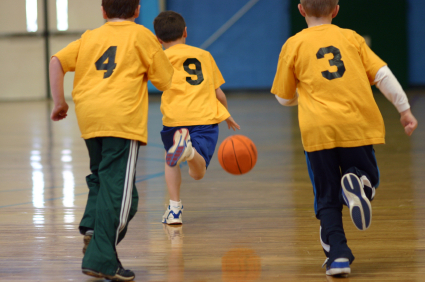Modifications
So here are my key modifications of the game for younger players:
- Play 3 on 3 using a half court with four sideline receivers/passers, one from each team on each side of the half court. This still gives each team a chance to involve five children in the game but the main action on the floor is 3 on 3. Whenever the kids on the floor get bottled up, they have an opportunity to pass it to one of their teammates on the sideline who passes it back in to another teammate on the floor. This creates additional options and teaches the importance of width for play the game, while still allowing for less congestion on the court itself.

- After any play, the team that did not have the ball brings it out to half court, just as in any half-court game. This provides the kids the chance to set up a play every time, with much less opportunity for steals and more opportunities to pass and move the ball. It is always easier for kids to play defense than offense, but offense is the skill they need to learn the most. When kids play full court, they can run much faster than they can competently handle the ball, so youth games always are a mass of bodies and confusion all over the place with too many turnovers and too little actual play that looks remotely like basketball.
- The sideline receivers/passers still have an opportunity to be involved, but in a more structured way where they can attempt to make good passes with much less confusion, and increase their skills as well. As play progresses, you want to switch the kids around, of course, so everyone gets a chance to play all of the different positions.
Other features and benefits
- More kids play. 3 on 3 half court puts 20 kids on a full court" at once (two teams of 3 plus 4 sideline players on each half court - times two half courts). This is twice as many kids in the same gym space as traditional 5 on 5, so programs can accommodate more kids or provide more play time for the kids they already have.
- Even distribution of touches. 3 on 3 provides a more even distribution of touches. In order to move the ball with both "width" and "depth" of play, the weakest player now can get at least 25% of the on-court touches (as opposed to 10% in 5 on 5), even if the other two on the court share 75%.
- More touches overall. 3 on 3 half-court also provides more touches overall for everyone. Since the ball doesn't have to be continuously advanced from back to front court (only taken back to top of key or foul line), the ball will spend more time being passed to multiple players.
- Eliminates presses and zones. The half-court 3-on-3 game eliminates any half and full-court presses and ZONES (!) that cause frantic attempts at passing and dribbling. The pace of the game is slowed considerably to a speed where more effective learning and practicing of skills is achievable. I have often called full court hoops for elementary school-aged players "STAMPEDE ball" (or "pint-sized rugby" as a friend noted recently!). Again, the speed of the children running far outstrips their ability to work at a moderated pace on the key offensive skills, which are dribbling, passing, and shooting. Plus, only man-to-man defense should be played to focus on basic 1-on-1 offense / defense play skills.
- Less congestion. Fewer players creates a less congested basket area. Six kids close to the hoop instead of ten crammed in allows for freer movement to open spaces when "moving without the ball". In addition, individual and team defensive skills can be developed more quickly, with less confusion and the ability of kids to guard their "man".
- Use extra players as sideline receivers on the half-court sidelines. Again, they can receive passes from their teammates but the only thing they can then do is pass it back to one of the three on the court. Since the defense is always more "skilled" (less unskilled!) at these ages (they don't have a ball to hold to make them more uncoordinated and off-balance), this gives a much-needed boost to offensive players who have curtailed their dribbles and can't pass to his/her other two teammates because they're overplayed or nowhere nearby. This also still allows ten kids total to play.
- Substitute out the player who just scored for one of your sideline players. Players just might discover that passing is important; after all it keeps them on the court. It also presents an intriguing dilemma (do I shoot, score and "leave", or pass and "stay"?) for a youngster. A 12-year old gave me this idea 20 years ago - sometimes students become teachers!
- Make a rule that every player on offense must touch the ball before a shot is taken. This ensures the development of ball handling skills and gets kids to focus on basic team play (sharing) before wildly shooting the ball. While developing shooting skills is a vital part of the game, moving without the ball and getting open is an important concept that they can learn in stages long before they will able to shoot with any degree of success. A typical 5th or 6th grade 5 on 5 full court game using 10-foot hoops will result in under 10% shooting from the field; even girls and boys high school varsities shoot as low as 25%. Shooting takes ten of thousands of mechanically-sound repetitions (and post-pubescent strength) before proper technique and "muscle memory" kick in. Basic 3-on-3 play with dribbling, passing, setting picks, moving to space, etc, can be learned better under the right conditions.








